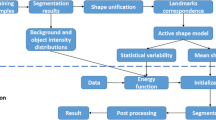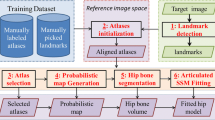Abstract
Purpose
Automated patient-specific image-based segmentation of tissues surrounding aseptically loose hip prostheses is desired. For this we present an automated segmentation pipeline that labels periprosthetic tissues in computed tomography (CT). The intended application of this pipeline is in pre-operative planning.
Methods
Individual voxels were classified based on a set of automatically extracted image features. Minimum-cost graph cuts were computed on the classification results. The graph-cut step enabled us to enforce geometrical containment constraints, such as cortical bone sheathing the femur’s interior. The solution’s novelty lies in the combination of voxel classification with multilabel graph cuts and in the way label costs were defined to enforce containment constraints.
Results
The segmentation pipeline was tested on a set of twelve manually segmented clinical CT volumes. The distribution of healthy tissue and bone cement was automatically determined with sensitivities greater than 82% and pathological fibrous interface tissue with a sensitivity exceeding 73%. Specificity exceeded 96% for all tissues.
Conclusions
The addition of a graph-cut step improved segmentation compared to voxel classification alone. The pipeline described in this paper represents a practical approach to segmenting multitissue regions from CT.
Article PDF
Similar content being viewed by others
Avoid common mistakes on your manuscript.
References
Agarwal S (2004) Osteolysis—basic science, incidence and diagnosis. Curr Orthop 18: 220–231. doi:10.1016/j.cuor.2004.03.002
de Poorter JJ, Hoeben RC, Hogendoorn S, Mautner V, Ellis J, Obermann WR, Huizinga TWJ (2008) Gene therapy and cement injection for restabilization of loosened hip prostheses. Hum Gene Ther 19: 83–95. doi:10.1089/hum.2007.111
Raaijmaakers M, Mulier M (2010) Percutaneous in situ cementation of a loose femoral stem. J Arthroplast 25:1169.e21–1169.e24. doi:10.1016/j.arth.2009.03.027
Cody DD, Gross GJ, Hou J, Spencer HJ, Goldstein SA, Fyhrie DP (1999) Femoral strength is better predicted by finite element models than QCT and DXA. J Biomech 32: 1013–1020. doi:10.1016/S0021-9290(99)00099-8
Schileo E, Taddei F, Malandrino A, Cristofolini L, Viceconti M (2007) Subject-specific finite element models can accurately predict strain levels in long bones. J Biomech 40: 2982–2989. doi:10.1016/j.jbiomech.2007.02.010
Garcia-Cimbrelo E, Tapia M, Martin-Hervas C (2007) Multislice computed tomography for evaluating acetabular defects in revision THA. Clin Orthop Relat Res 463: 138–143. doi:10.1097/BLO.0b013e3181566320
Walde TA, Weiland DE, Leung SB, Kitamura N, Sychterz CJ, Engh CA, Claus AM, Potter HG (2005) Comparison of CT, MRI, and radiographs in assessing pelvic osteolysis: a cadaveric study. Clin Orthop Relat Res 437: 138–144. doi:10.1097/01.blo.0000164028.14504.46
Cahir JG, Toms AP, Marshall TJ, Wimhurst J (2007) CT and MRI of hip arthroplasty. Clin Radiol 62: 1163–1171. doi:10.1016/j.crad.2007.04.018
Watzke O, Kalender W (2004) A pragmatic approach to metal artifact reduction in CT: merging of metal artifact reduced images. Eur Radiol 14: 849–856. doi:10.1007/s00330-004-2263-y
Liu P, Pavlicek W, Peter M, Spangehl M, Roberts C, Paden R (2009) Metal artifact reduction image reconstruction algorithm for CT of implanted metal orthopedic devices: a work in progress. Skeletal Radiol 38: 797–802. doi:10.1007/s00256-008-0630-5
Zoroofi RA, Sato Y, Sasama T, Nishii T, Sugano N, Yonenobu K, Yoshikawa H, Ochi T, Tamura S (2003) Automated segmentation of acetabulum and femoral head from 3-D CT images. IEEE Trans Inf Technol Biomed 7: 329–343. doi:10.1109/TITB.2003.813791
Kang Y, Engelke K, Kalender WA (2003) A new accurate and precise 3-D segmentation method for skeletal structures in volumetric CT data. IEEE Trans Med Imaging 22: 586–598. doi:10.1109/TMI.2003.812265
Yokota F, Okada T, Takao M, Sugano N, Tada Y, Sato Y (2009) Automated segmentation of the femur and pelvis from 3D CT data of diseased hip using hierarchical statistical shape model of joint structure. Med Image Comput Comput Assist Interv 12: 811–818. doi:10.1007/978-3-642-04271-3_98
Shlens J (2005) A tutorial on principal component analysis. Systems Neurobiology Laboratory, Salk Institute for Biological Studies. http://www.snl.salk.edu/~shlens/pca.pdf. Accessed 16 Nov 2011
Sharma N, Aggarwal LM (2010) Automated medical image segmentation techniques. J Med Phys 35: 3–14. doi:10.4103/0971-6203.58777
Malan DF, Botha CP, Nelissen RGHH, Valstar ER (2010) Voxel classification of periprosthetic tissues in clinical computed tomography of loosened hip prostheses. In: Proceedings of the IEEE international symposium on biomedical imaging: from nano to macro, Rotterdam, The Netherlands, pp 1341–1344
Boykov Y, Veksler O, Zabih R (2001) Fast approximate energy minimization via graph cuts. IEEE Trans Pattern Anal Mach Intell 23: 1222–1239. doi:10.1109/34.969114
Delong A, Boykov Y (2009) Globally optimal segmentation of multi-region objects. In: Proceedings of the IEEE 12th international computer vision conference, Kyoto, Japan, pp 285–292
Veksler O (2010) Code: multi-label optimization. University of Western Ontario. http://vision.csd.uwo.ca/code/. Accessed 22 Sept 2010
Maleike D, Nolden M, Meinzer HP (2009) Interactive segmentation framework of the medical imaging interaction toolkit. Comput Methods Programs Biomed 96: 72–83. doi:10.1016/j.cmpb.2009.04.004
van der Lijn F, den Heijer T, Breteler MMB (2008) Hippocampus segmentation in MR images using atlas registration, voxel classification, and graph cuts. Neuroimage 43: 708–720. doi:10.1016/j.neuroimage.2008.07.058
Zou KH, Warfield SK, Bharatha A, Tempany CMC, Kaus MR, Haker SJ, Wells WM, Jolesz FA, Kikinis R (2004) Statistical validation of image segmentation quality based on a spatial overlap index. Acad Radiol 11: 178–189. doi:10.1016/S1076-6332(03)00671-8
Kalender WA, Hebel R (1987) Reduction of CT artifacts caused by metallic implants. Radiology 164: 576–577
Botha CP (2008) Hybrid scheduling in the DeVIDE dataflow visualisation environment. In: Hauser H, Strassburger S, Theisel H (eds) Proceedings of simulation and visualization, pp 309–322
Loog M, van Ginneken B (2006) Segmentation of the posterior ribs in chest radiographs using iterated contextual pixel classification. IEEE Trans Med Imaging 25: 602–611. doi:10.1109/TMI.2006.872747
Folkesson J, Dam EB, Olsen OF, Pettersen PC (2007) Segmenting articular cartilage automatically using a voxel classification approach. IEEE Trans Med Imaging 26: 106–115
van Rikxoort EM, de Hoop B, van de Vorst S, Prokop M (2009) Automatic segmentation of pulmonary segments from volumetric chest CT scans. IEEE Trans Med Imaging 28: 621–630. doi:10.1109/TMI.2008.2008968
Paclik P, Lai C (2011) PRSD Studio. PR Sys Design, Delft, The Netherlands. http://www.prsdstudio.com/. Accessed 16 Nov 2011
Greig DM, Porteous BT (1989) Exact maximum a posteriori estimation for binary images. J R Stat Soc Ser B Stat Methodol 51: 271–279
Ahuja RK, Magnanti TL, Orlin JB (1993) Maximum flows: polynomial algorithms. In: Janzow P, Peterson M (eds) Network flows. Prentice Hall, Englewood Cliffs, New Jersey, p 240
Boykov Y, Kolmogorov V (2004) An experimental comparison of min-cut/max-flow algorithms for energy minimization in vision. IEEE Trans Pattern Anal Mach Intell 26: 1124–1137. doi:10.1109/TPAMI.2004.60
Kolmogorov V, Zabin R (2004) What energy functions can be minimized via graph cuts?. IEEE Trans Pattern Anal Mach Intell 26: 147–159. doi:10.1109/TPAMI.2004.1262177
Egger J, Colen RR, Freisleben B, Nimsky C (2011) Manual refinement system for graph-based segmentation results in the medical domain. J Med Syst. doi:10.1007/s10916-011-9761-7
Schwarz EM, Campbell D, Totterman S, Boyd A, O’Keefe RJ (2003) Use of volumetric computerized tomography as a primary outcome measure to evaluate drug efficacy in the prevention of peri-prosthetic osteolysis: a 1-year clinical pilot of etanercept vs. placebo. J Orthop Res 21: 1049–1055. doi:10.1016/S0736-0266(03)00093-7
Malan DF, Botha CP, Kraaij G, Joemai RM, van der Heide HJL, Nelissen RGHH, Valstar ER (2011) Measuring femoral lesions despite CT metal artefacts: a cadaveric study. Skeletal Radiol. doi:10.1007/s00256-011-1223-2
Acknowledgments
This research is supported by the Dutch Technology Foundation STW, which is the applied science division of NWO, and the Technology Programme of the Ministry of Economic Affairs (project number LKG 7943). The authors sincerely thank Professor Rob Nelissen for verifying the correctness of the manually segmented ground truth and Noeska Smit for the re-segmentation of several of the data sets for evaluating inter-observer variability.We furthermore thank David Tax and Marco Loog from the pattern recognition group at Delft University of Technology for their helpful input.
Open Access
This article is distributed under the terms of the Creative Commons Attribution Noncommercial License which permits any noncommercial use, distribution, and reproduction in any medium, provided the original author(s) and source are credited.
Author information
Authors and Affiliations
Corresponding author
Rights and permissions
Open Access This is an open access article distributed under the terms of the Creative Commons Attribution Noncommercial License (https://creativecommons.org/licenses/by-nc/2.0), which permits any noncommercial use, distribution, and reproduction in any medium, provided the original author(s) and source are credited.
About this article
Cite this article
Malan, D.F., Botha, C.P. & Valstar, E.R. Voxel classification and graph cuts for automated segmentation of pathological periprosthetic hip anatomy. Int J CARS 8, 63–74 (2013). https://doi.org/10.1007/s11548-012-0671-z
Received:
Accepted:
Published:
Issue Date:
DOI: https://doi.org/10.1007/s11548-012-0671-z




